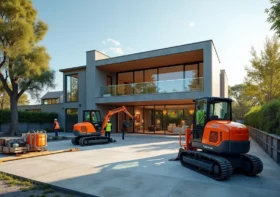Construction Delivery Methods That Fit Modern Commercial Needs

The construction industry is evolving, adapting to the demands of modern commercial projects. As businesses expand and change, the methods used to deliver construction services are transforming.
Selecting the right construction delivery method can significantly impact the project’s success, influencing timelines, budgets, and the quality of the build. Understanding the various approaches available helps business owners make informed decisions that align with their specific project requirements.
Contents
Understanding Construction Delivery Methods
Construction delivery methods are defined processes through which projects are designed and constructed. Each method offers unique advantages and challenges, making it crucial for stakeholders to assess their specific project goals before deciding on a delivery approach.
The most common methods include General Contracting, Design-Bid-Build, Construction Management at Risk, and Design-Build. These traditional methods have formed the backbone of the construction industry for decades, but in recent years, more innovative strategies such as Integrated Project Delivery (IPD) have emerged to meet modern needs.
Selecting a delivery method requires a comprehensive understanding of the project scope, budget constraints, and timelines. Design-Bid-Build is often perceived as the most conventional approach, where the design and construction phases are distinctly separated. It is vital to recognize that this method can lead to extended timelines, as it typically involves lengthy bidding processes.
Therefore, when time efficiency is critical, stakeholders may lean toward alternatives like Construction Management at Risk, which allows for parallel execution of design and construction stages. Even with established methods, the effectiveness can vary based on the specific project requirements and complexities involved.
Pros and Cons of Popular Construction Delivery Methods
Each construction delivery method presents its own benefits and drawbacks, dictating its suitability for different types of projects. The General Contracting method offers a straightforward approach where a single contractor oversees all aspects of the project.
This can simplify communication for clients but might lead to less flexibility when it comes to changes during the construction phase. On the other hand, the Design-Bid-Build method ensures comprehensive planning and design oversight but can create potential conflicts if unforeseen changes arise.
Construction Management at Risk, while potentially more expensive, allows for increased collaboration between contractors and owners. This collaboration fosters a proactive approach, helping to mitigate risks associated with budget overruns and project delays.
A growing method, Design-Build, combines design and construction under one contract, establishing a seamless transition between phases. Although faster, it requires a high level of trust between owners and contractors to succeed.
Choosing the Right Method for Your Project
Selecting the most appropriate construction delivery method does not have a one-size-fits-all answer. Factors such as size, complexity, and budget all play critical roles in determining which method will yield the best results.
A smaller commercial renovation may not require the extensive resources associated with an Integrated Project Delivery approach, while a complex mixed-use development would likely benefit from its collaborative nature and risk-sharing attributes.
The experience and capacity of the team involved are pivotal. A highly skilled commercial contractor team can navigate various methods effectively, adapting strategies to suit the specific needs of each unique project. Evaluating past performance and references for potential contractors should be part of an in-depth selection process to ensure alignment with client expectations and project scope.
Integrated Project Delivery for Efficiency
Integrated Project Delivery (IPD) is an innovative approach that emphasizes collaboration among all stakeholders from the very start. Utilizing this method, commercial projects take advantage of shared risks and rewards among parties, including the owner, architect, and contractor.
One of the compelling features of IPD is the enhanced communication it fosters, breaking down traditional silos that have long plagued construction projects. This heightened collaboration can result in significant improvements in scheduling and cost efficiency, vital aspects for commercial projects in competitive markets.
As the demand for quicker turnarounds increases, modern companies are exploring IPD, supported by advanced construction technologies that facilitate real-time collaboration. Adopting this method often requires a cultural shift within organizations, as it calls for transparency and shared accountability among all project participants. By engaging a cohesive team, clients stand to benefit from a well-coordinated construction effort from concept to completion.
Future Trends in Construction Delivery Methods
As the construction continues to evolve, new methodologies will likely emerge to challenge traditional practices, driven by innovations in technology and shifting economic conditions. Increasingly, sustainable practices are being integrated into construction delivery methods, emphasizing the importance of green building materials and energy-efficient designs. Clients increasingly seek methods that align with environmental sustainability. Methods facilitating energy-efficient strategies will have increased appeal.
Technology such as Building Information Modeling (BIM) enhances efficiency in coordination, reducing conflicts and improving project accuracy. This technology allows various teams to visualize the entire project digitally, leading to better planning and execution.
The future of construction is interlinked with digital advancements, and the effective utilization of these technologies can be a decisive factor influencing a project’s delivery success on time and within budget. Stakeholders who embrace these trends and adapt their delivery methods accordingly will likely see greater satisfaction in their projects’ outcomes.
Collaboration and Communication in Delivery Methods
Beyond the technical aspects of project management, the success of any construction delivery method heavily depends on the strength of communication and collaboration among stakeholders. Owners, architects, contractors, and subcontractors must remain aligned in their goals, expectations, and timelines to prevent delays and minimize disputes.
Clear channels of communication ensure that challenges are addressed quickly and that all parties are informed of progress or changes throughout the project lifecycle.
In recent years, collaborative tools and digital platforms have played a pivotal role in enhancing communication within construction projects. Platforms for project tracking, cloud-based documentation, and real-time updates help unify teams, even when working across different locations.
Whether a project adopts traditional methods or innovative approaches like IPD, the ability to foster collaboration and transparency can significantly influence the project’s efficiency, cost control, and success.
Construction delivery methods are at the heart of modern commercial development, shaping how efficiently and effectively projects are completed. Each method offers distinct advantages and challenges, and selecting the right one requires a careful evaluation of project size, complexity, budget, and team expertise.
As technology and sustainability continue to reshape the industry, methods that embrace collaboration, efficiency, and adaptability will dominate the future. For business owners and developers, understanding these delivery methods ensures projects are positioned for long-term success.



